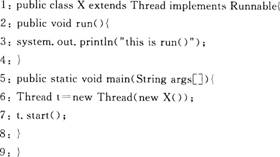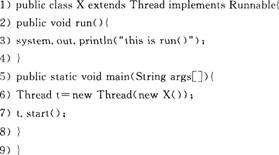阅读下列代码后正确的说法是( )。A.编译时将产生错误B.编译时正确,运行时将产生错误C.输出零D.输出空
题目
阅读下列代码后 正确的说法是( )。
正确的说法是( )。
A.编译时将产生错误
B.编译时正确,运行时将产生错误
C.输出零
D.输出空
相似考题
更多“阅读下列代码后正确的说法是( )。A.编译时将产生错误B.编译时正确,运行时将产生错误C.输出零D.输出空”相关问题
-
第1题:
下列代码经过编译将输出()。

A.99
B.0
C.编译出错
D.运行出错
正确答案:C
-
第2题:
对下列程序的叙述中,正确的是( )。 A.第1行会产生编译错误B.第6行会产生编译错程SXB对下列程序的叙述中,正确的是( )。

A.第1行会产生编译错误
B.第6行会产生编译错程
C.第6行会产生运行错误
D.程序正常运行
正确答案:D
程序正常运行打印thisisrun()。用Thread类的构造方法Thread(Runnabletarget)创建线程对象时,构造方法中的参数必须是-个具体的对象,该对象称作线程的目标对象,创建的目标对象的类必须实现Runna-ble接口。 -
第3题:
阅读下面代码 public class Person { static int arr[]=new int[10]; public static void main(String args) { System.out.println(arr[9]); } } 该代码的运行结果是
A.编译时将产生错误
B.编译时正确,运行时将产生错误
C.输出零
D.输出空
正确答案:B
解析:Java程序中,main()方法的格式为public staric void main(String args[]) { },返回值为void,参数必须为字符数组。本题目程序的参数不是字符数组,编译不会出错,但是运行时会找不到main()方法,程序无法执行。 -
第4题:
给出下列的程序,其叙述正确的是public class Man { static int arr[]= new int [10]; public static void main (String a []){ System.out.println(arr[1]); }}
A.编译时将发生错误
B.编译时正确但是运行时出错
C.输出为0
D.输出为null
正确答案:C
解析:由于数组元素是整型,所以其初始值为0。 -
第5题:
对下列程序的叙述中,正确的是( )。 A.第1行会产生编译错误B.第6行会产生编译错误SXB对下列程序的叙述中,正确的是( )。

A.第1行会产生编译错误
B.第6行会产生编译错误
C.第6行会产生运行错误
D.程序正常运行
正确答案:D
程序正常运行打印thisisrun()。用Thread类的构造方法Thread(Runnabletarget)创建线程对象时,构造方法中的参数必须是一个具体的对象,该对象称作线程的目标对象,创建的目标对象的类必须实现Runnable接口。 -
第6题:
阅读下列代码后 publicclass Person{ intarr[]=new int[10]; publicstaticvoidmain(Stringargs[]){ System.out.println(alt[1]); } } 正确的说法是( )。
A.编译时将产生错误
B.编译时正确,运行时将产生错误
C.输出零
D.输出空
正确答案:A
解析: 本题考查考生对Java中数组的定义及使用。int alt[]=newint[10]表示数组alt是一个含有10个元素的整数数组。Java中的数据类型必须实例化后才能使用,但是有种情况例外,就是该成员是用static声明的。题目中对于数组并没有实例化,因此不能使用,所以选项A说法正确。如果加上static修饰符,改为static int arr[]=newint[10]或者将该数组实例化即可,输出为0。 -
第7题:
对于下列代码正确的说法是()

A.编译时将产生错误
B.编译时正确,运行时将产生错误
C.输出零
D.输出空
正确答案:A
-
第8题:
编译和运行以下代码的结果为:public class MyMain{public static void main(String argv){System.out.println("Hello cruel world");}}A.编译错误;
B.运行输出 "Hello cruel world";
C.编译无错,但运行时指示没有定义构造方法。
D.编译无错,但运行时指示没有正确定义main方法。
正确答案:D
-
第9题:
假设在某JSP页面中存在“〈s:property〉”代码,则以下说法正确的是()。
- A、编译JSP页面时会出现错误
- B、编译JSP页面时不会出现错误,但页面不会显示任何内容
- C、该代码用于输出位于ValueStack(值栈)栈顶的对象
正确答案:C -
第10题:
"分析下面这行代码if(5&7>0&&5|2)Systen.out.println(""true""),选择唯一正确的说法()"
- A、这行代码不能编译
- B、代码编译,无任何输出
- C、代码编译,输出true
- D、代码编译,输出false
正确答案:A -
第11题:
单选题关于以下程序段的说法正确的是()。 1.publicclassMyar{ 2.publicstaticvoidmain(Stringargv[]){ 3.int[]i=newint[5] 4.System.out.println(i[5]) 5.}A第2行编译出错
B第4行编译出错
C编译时产生错误
D编译时没有产生错误,运行时发生异常
正确答案: D解析: 暂无解析 -
第12题:
单选题假设在某JSP页面中存在””代码,则以下说法正确的是()A编译JSP页面时会出现错误
B编译JSP页面时不会出现错误,但页面不会显示任何内容
C该代码用于输出位于ValueStack(值栈)栈顶的对象
D以上说法都不正确
正确答案: D解析: 暂无解析 -
第13题:
classOrder3implementsRunnable{publicstaticvoidmain(String[]args){newThread(newOrder3()).start();for(intx=0;x〈10;x++)System.out.print("m");}publicvoidrun(){for(intx=0;x〈10;x++){//insertcodehereSystem.out.print("r");}}}和:当代码被编译并照此运行时产生"before"的输出,当下列内容插入到代码第8行时产生"after"输出if(x〉3&&x〈7)Thread.yield();对比before”的输出结果和after”的输出结果,下面哪一项是正确的?()
A.输出字符的总数可能改变。
B.当添加额外的代码时,编译将失败。
C.在“after”输出结果中,字符“m”较早出现的可能性较小。
D.在“after”输出结果中,字符“m”较早出现的可能性较大。
参考答案:D
-
第14题:
阅读下列程序:class ThreadTest extends Thread{ public static void main(String[]args){ Thread t=new Thread(this); t.start(); } public void run(){ System.out.print("A thread test."); }} 对该程序而言,正确结论是 ( )
A.该程序能够通过编译并打印输出“A thread test.”
B.该程序能够通过编译,但运行时将不调用ThreadTest类中的run()方法,因此不产生任何输出
C.该程序存在编译错误,因为在main()方法中不能使用this指针
D.上述选项都不正确
正确答案:C
解析:该题是对this知识点的考查。该程序在编译存在错误,在main()方法中不能使用this。所以选项A、B、C的说法是错误的。 -
第15题:
阅读下列代码 publicclassPerson{ staticintalt[]=newint[[10]; public static voidmain(Stringargs){ System.out.println{all[9]); } } 该代码的运行结果是( )。
A.编译时将产生错误
B.编译时正确,运行时将产生错误
C.输出零
D.输出空
正确答案:C
解析:arr[]为整[]型数组,分配地址后默认值为0,所以创建数组时也是对每个数组元素赋初值0。 -
第16题:
阅读下列代码: public class Person{ static int arr[]=new int[10]; public static void main(String args){ System.out.println{arr[9]); } } 该代码的运行结果是( )。
A.编译时将产生错误
B.编译时正确,运行时将产生错误
C.输出零
D.输出空
正确答案:C
C。【解析】arr[]为整型数组,分配地址后默认值为0,所以创建数组时也是对每个数组元素赋初值0。 -
第17题:
阅读下列代码:
 该代码的运行结果是( )。
该代码的运行结果是( )。A.编译时将产生错误
B.编译时正确,运行时将产生错误
C.输出零
D.输出空
正确答案:C
arr[]为整型数组,分配地址后默认值为0,所以创建数组时也是对每个数组元素赋初值0。 -
第18题:
关于以下程序段的执行结果,说法正确的是()。publicclassborleyextendsThread(publicstaticvoidmain(Stringargv[]){borleyb=newborley();b.start();}publicvoidrun(){System.out.println("running");}}
A.编译通过并执行,但无输出
B.编译通过并执行,输出:running
C.产生错误,没有thread类对象
D.产生错误,没有通道到达thread包
正确答案:B
-
第19题:
给出下面的程序: public class ex49 { static int arr[] = new int[10]; public static void main(String args [] ) { System.out.println (art [1] ); } } ______叙述是正确的。
A.编译时将发生错误
B.输出为 null
C.输出为0
D.编译时正确但是运行时出错
正确答案:C
-
第20题:
给出下面代码:public class Person{static int arr[] = new int[10];public static void main(String a[]) {System.out.println(arr[1]);}}以下那个说法正确?A. 编译时将产生错误;
B. 编译时正确,运行时将产生错误;
C. 输出0;
D. 输出null。
正确答案:C
-
第21题:
关于以下程序段的说法正确的是()。 1.publicclassMyar{ 2.publicstaticvoidmain(Stringargv[]){ 3.int[]i=newint[5] 4.System.out.println(i[5]) 5.}
- A、第2行编译出错
- B、第4行编译出错
- C、编译时产生错误
- D、编译时没有产生错误,运行时发生异常
正确答案:D -
第22题:
在JAVA语言中,为将源代码翻译成()文件时产生的错误称为编译错误。而将程序在运行中产生的错误称为运行错误。
正确答案:字节码 -
第23题:
单选题"分析下面这行代码if(5&7>0&&5|2)Systen.out.println(""true""),选择唯一正确的说法()"A这行代码不能编译
B代码编译,无任何输出
C代码编译,输出true
D代码编译,输出false
正确答案: A解析: 暂无解析
